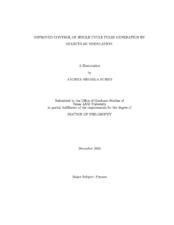| dc.description.abstract | Generation of reproducible attosecond (10-18s) pulses is an exciting goal: in the
same way as femtosecond pulses were used to make "movies" of the atomic motion
in molecules, attosecond pulses could "uncover" the motion of electrons around nuclei.
In this dissertation, we have suggested new ideas that will allow improving one
scheme for obtaining such ultra-short pulses: the molecular modulation technique. In
a theoretical proposal called Raman Additive technique, we have suggested a method
that will allow (with a proper phase stabilization of generated sidebands) to obtain
reproducible waveforms of arbitrary shape. An exciting range of possibilities could
open up - not only for absolute phase control or sub-cycle shape control, but also for
investigation of multiphoton ionization rates as a function of the sub-cycle shape. We
have elaborated on the latter subject in another theoretical project, where we have
exploited the unique feature of such ultrashort laser pulses, which is synchronization
with molecular motion (rotational or vibrational), in order to investigate photoionization
of molecules. From experimental point of view, a different construction of driving
lasers than previously employed led to establishment of larger molecular coherences
at higher operating pressure than in previous experiments. This resulted in simultaneous
generation of rotational and vibrational sidebands with only two fields applied.
In another experimental proposal using rotational transition in deuterium we have shown that employing a hollow waveguide instead of normal Raman cell improves
the efficiency of the generation process. By optimizing gas pressure and waveguide
geometry to compensate the dispersion, the method can be extended to efficiently
generate Raman sidebands at a much lower energy of driving fields than previously
employed. At the end, a very exciting possibility for controlling the molecular motion
in a Raman driven system will be shown. Based on the interference effects (EITlike)
that take place inside of a molecule, selectivity of different degrees of freedom
can be achieved (for example switching from rotational-vibrational motion to pure
rotational). | en |


